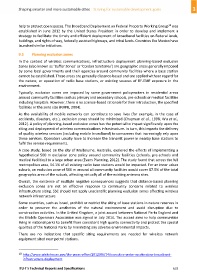Page 643 - Shaping smarter and more sustainable cities - Striving for sustainable development goals
P. 643
18
help to protect open spaces. The Broadband Deployment on Federal Property Working Group was
established in June 2012 by the United States President in order to develop and implement a
strategy to facilitate the timely and efficient deployment of broadband facilities on Federal lands,
buildings, and rights of way, federally assisted highways, and tribal lands. Countries like Mexico have
launched similar initiatives.
9.5 Planning exclusion zones
In the context of wireless communications, infrastructure deployment planning‐based exclusion
zones (also known as ‘Buffer Zones’ or ‘Cordon Sanitaires’) are geographic areas generally imposed
by some local governments and their agencies around community facilities where a base station
cannot be established. These areas are generally distance‐based and are applied without regard for
the nature, or operation of radio base stations, or existing sources of RF‐EMF exposure in the
environment.
Typically, exclusion zones are imposed by some government policymakers in residential areas
around community facilities such as primary and secondary schools, pre‐schools or medical facilities
including hospitals. However, there is no science‐based rationale for their introduction, the specified
facilities or the zone size (NRPB, 2004).
As the availability of mobile networks can contribute to save lives (for example, in the case of
accidents, disasters, etc.), exclusion zones should be minimized (Chapman et al., 1998; Wu et al.,
2012). A policy of planning‐based exclusion zones has the potential to impact significantly upon the
siting and deployment of wireless communications infrastructure. In turn, this impacts the delivery
of quality wireless services (including mobile broadband) to consumers that increasingly rely upon
these services. Operators usually have to increase the transmit power in nearby base stations to
fulfil the service requirements.
A case study, based on the city of Melbourne, Australia, explored the effects of implementing a
hypothetical 500 m exclusion zone policy around community facilities (schools, pre‐schools and
medical facilities) to a large urban area (Evans Planning, 2012). The study found that across the full
metropolitan area, 54.1% of all existing radio base stations would be impacted. For an inner urban
suburb, an exclusion zone of 500 m around all community facilities would cover 87.5% of the total
geographic area of the suburb, affecting virtually all of the existing antenna sites.
Overall, the existence of multiple negative consequences suggests that distance‐based planning
exclusion zones are not an effective response to community concerns related to wireless
infrastructure siting. SSC should not apply unscientific planning exclusion zones affecting wireless
network infrastructure.
Some countries, such as Israel, prohibit or restrict the siting of base stations in nature reserves in
order to preserve the aesthetics of the natural environment and avoid disruption due to
construction activities. In the United Kingdom, a joint accord between National Parks England and
the Mobile Operators Association was signed in July 2014. The accord aims to help communities
living in national parks to benefit from consistent high quality connectivity and protect the special
qualities of the National Parks by minimizing any adverse environmental impacts.
There are no indications that specific siting requirements are needed for wireless network
equipment sited near petrol stations.
____________________
18 http://www.whitehouse.gov/the‐press‐office/2012/06/14/executive‐order‐accelerating‐broadband‐
infrastructure‐deployment
ITU‐T's Technical Reports and Specifications 633

